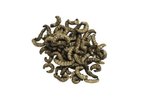
The grasshopper is a flying animal belonging to order Orthoptera and class Insecta. About 11,000 species exist. They are herbivorous and commonly seen in autumn; a few appear in summer and spring. During mating the male grasshopper deposits sperm into the female's vagina, which finds its way to the eggs through canals known as micropyles. An adult grasshopper goes through the stages egg, nymph and adult, and has a lifespan of approximately one year.
Egg
This is the initial stage of a grasshopper's life cycle. The mother grasshopper lays fertilized eggs in midsummer, and they remain 1 or 2 inches under the sand or in leaf litter. She sprinkles them with a sticky semisolid substance that sets to form an egg pod. Each egg pod contains 15 to 150 eggs, depending on the species. Normally a female grasshopper can lay up to 25 pods. The eggs remain underneath for about 10 months in autumn and winter before hatching into nymphs during spring or in the initial days of summer.
Nymph
This is the second stage of the grasshopper's life cycle and the initial stage during which a young grasshopper sees the outside world. Nymphs look like adult grasshoppers, called molts, apart from the fact that they are wingless and lack reproductive organs. They undergo five substages known as instars before fully developing into adult grasshoppers; each instar is characterized by shedding of the cuticle skin and gradual growth of wings. In order to survive, nymphs start to feed on succulent and soft plant foliage barely one day after hatching from the egg. This stage lasts for about five to six weeks before the young nymphs mature to adult grasshoppers.
Molting
Molting takes place during the nymph stage. The locust sheds its exoskeleton before maturing into an adult. While the exoskeleton covers the nymph's body, providing it with protection against external injuries, it inhibits its growth because of its rigidity and inability to give room for expansion. The nymph has to shed it in order to achieve growth. It undergoes five to six molts in which it changes its structure and form before reaching adulthood.
Adult
This is a fully grown grasshopper. It takes about one month before the wings are fully developed. The mature grasshopper is more mobile than the nymph, a characteristic that helps them to hunt and flee from predators. The reproductive organs are fully grown, so the females can lay eggs and the males can fertilize. However, female grasshoppers do not lay eggs until they are 1 or 2 weeks old, to allow them to gain enough weight before they start laying eggs. Once she starts laying eggs, the female continues to lay eggs at intervals of three to four days until she dies. Adult grasshoppers live for about two months, depending on the weather.
References
Photo Credits
-
Jupiterimages/Photos.com/Getty Images
Writer Bio
Kendal Elizabeth has been a professional writer and editor since 2001. She has specialized in writing pet-related topics, home decor and gardening. Her work has appeared on several online and offline publication. Elizabeth holds a Bachelor of Science in Animal Science with a minor in marine biology from Cornell University.




